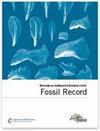下载PDF
{"title":"坦达古鲁组(坦桑尼亚南部晚侏罗世至早白垩世):定义、古环境和层序地层学","authors":"Robert Bussert, Wolf-Dieter Heinrich, Martin Aberhan","doi":"10.1002/mmng.200900004","DOIUrl":null,"url":null,"abstract":"<p>The well-known Late Jurassic to Early Cretaceous Tendaguru Beds of southern Tanzania have yielded fossil plant remains, invertebrates and vertebrates, notably dinosaurs, of exceptional scientific importance. Based on data of the German-Tanzanian Tendaguru Expedition 2000 and previous studies, and in accordance with the international stratigraphic guide, we raise the Tendaguru Beds to formational rank and recognise six members (from bottom to top): Lower Dinosaur Member, <i>Nerinella</i> Member, Middle Dinosaur Member, <i>Indotrigonia africana</i> Member, Upper Dinosaur Member, and <i>Rutitrigonia bornhardti-schwarzi</i> Member. We characterise and discuss each member in detail in terms of derivation of name, definition of a type section, distribution, thickness, lithofacies, boundaries, palaeontology, and age. The age of the whole formation apparently ranges at least from the middle Oxfordian to the Valanginian through Hauterivian or possibly Aptian. The Tendaguru Formation constitutes a cyclic sedimentary succession, consisting of three marginal marine, sandstone-dominated depositional units and three predominantly coastal to tidal plain, fine-grained depositional units with dinosaur remains. It represents four third-order sequences, which are composed of transgressive and highstand systems tracts. Sequence boundaries are represented by transgressive ravinement surfaces and maximum flooding surfaces. In a more simple way, the depositional sequences can be subdivided into transgressive and regressive sequences/systems tracts. Whereas the transgressive systems tracts are mainly represented by shallow marine shoreface, tidal channel and sand bar sandstones, the regressive systems tracts predominantly consist of shallow tidal channel, tidal flat, and marginal lagoonal to supratidal deposits. (© 2009 WILEY-VCH Verlag GmbH & Co. KGaA, Weinheim)</p>","PeriodicalId":55147,"journal":{"name":"Fossil Record","volume":"12 2","pages":"141-174"},"PeriodicalIF":1.4000,"publicationDate":"2009-08-03","publicationTypes":"Journal Article","fieldsOfStudy":null,"isOpenAccess":false,"openAccessPdf":"https://sci-hub-pdf.com/10.1002/mmng.200900004","citationCount":"52","resultStr":"{\"title\":\"The Tendaguru Formation (Late Jurassic to Early Cretaceous, southern Tanzania): definition, palaeoenvironments, and sequence stratigraphy\",\"authors\":\"Robert Bussert, Wolf-Dieter Heinrich, Martin Aberhan\",\"doi\":\"10.1002/mmng.200900004\",\"DOIUrl\":null,\"url\":null,\"abstract\":\"<p>The well-known Late Jurassic to Early Cretaceous Tendaguru Beds of southern Tanzania have yielded fossil plant remains, invertebrates and vertebrates, notably dinosaurs, of exceptional scientific importance. Based on data of the German-Tanzanian Tendaguru Expedition 2000 and previous studies, and in accordance with the international stratigraphic guide, we raise the Tendaguru Beds to formational rank and recognise six members (from bottom to top): Lower Dinosaur Member, <i>Nerinella</i> Member, Middle Dinosaur Member, <i>Indotrigonia africana</i> Member, Upper Dinosaur Member, and <i>Rutitrigonia bornhardti-schwarzi</i> Member. We characterise and discuss each member in detail in terms of derivation of name, definition of a type section, distribution, thickness, lithofacies, boundaries, palaeontology, and age. The age of the whole formation apparently ranges at least from the middle Oxfordian to the Valanginian through Hauterivian or possibly Aptian. The Tendaguru Formation constitutes a cyclic sedimentary succession, consisting of three marginal marine, sandstone-dominated depositional units and three predominantly coastal to tidal plain, fine-grained depositional units with dinosaur remains. It represents four third-order sequences, which are composed of transgressive and highstand systems tracts. Sequence boundaries are represented by transgressive ravinement surfaces and maximum flooding surfaces. In a more simple way, the depositional sequences can be subdivided into transgressive and regressive sequences/systems tracts. Whereas the transgressive systems tracts are mainly represented by shallow marine shoreface, tidal channel and sand bar sandstones, the regressive systems tracts predominantly consist of shallow tidal channel, tidal flat, and marginal lagoonal to supratidal deposits. (© 2009 WILEY-VCH Verlag GmbH & Co. KGaA, Weinheim)</p>\",\"PeriodicalId\":55147,\"journal\":{\"name\":\"Fossil Record\",\"volume\":\"12 2\",\"pages\":\"141-174\"},\"PeriodicalIF\":1.4000,\"publicationDate\":\"2009-08-03\",\"publicationTypes\":\"Journal Article\",\"fieldsOfStudy\":null,\"isOpenAccess\":false,\"openAccessPdf\":\"https://sci-hub-pdf.com/10.1002/mmng.200900004\",\"citationCount\":\"52\",\"resultStr\":null,\"platform\":\"Semanticscholar\",\"paperid\":null,\"PeriodicalName\":\"Fossil Record\",\"FirstCategoryId\":\"89\",\"ListUrlMain\":\"https://onlinelibrary.wiley.com/doi/10.1002/mmng.200900004\",\"RegionNum\":4,\"RegionCategory\":\"地球科学\",\"ArticlePicture\":[],\"TitleCN\":null,\"AbstractTextCN\":null,\"PMCID\":null,\"EPubDate\":\"\",\"PubModel\":\"\",\"JCR\":\"Q3\",\"JCRName\":\"Earth and Planetary Sciences\",\"Score\":null,\"Total\":0}","platform":"Semanticscholar","paperid":null,"PeriodicalName":"Fossil Record","FirstCategoryId":"89","ListUrlMain":"https://onlinelibrary.wiley.com/doi/10.1002/mmng.200900004","RegionNum":4,"RegionCategory":"地球科学","ArticlePicture":[],"TitleCN":null,"AbstractTextCN":null,"PMCID":null,"EPubDate":"","PubModel":"","JCR":"Q3","JCRName":"Earth and Planetary Sciences","Score":null,"Total":0}
引用次数: 52
引用
批量引用


